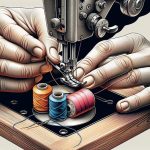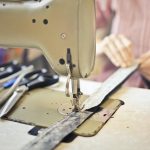Are you struggling with your sewing machine’s bobbin? It’s a common issue that can cause frustration and ruin your sewing projects. The bobbin is an essential part of any sewing machine, and when it’s not working correctly, it can cause uneven stitches, thread bunching, and other problems.
In this article, we’ll take a closer look at the bobbin and its role in sewing machines. We’ll also explore some common bobbin problems and their causes, as well as solutions for these issues.
Whether you’re a beginner or an experienced sewer, understanding how to troubleshoot bobbin problems can help you achieve better results and enjoy your sewing projects. So, let’s get started!
Table of Contents
Understanding the Bobbin and Its Role in Sewing Machines
Now, let’s take a closer look at the bobbin and how it works inside your sewing machine. You’ll see how it plays a crucial role in creating those beautiful stitches.
The bobbin is a small, circular spool that is placed in the lower part of your sewing machine. It’s usually made of plastic or metal and comes in different sizes to fit different machines.
The bobbin’s role in your sewing machine is to provide the thread for the bottom part of the stitch. When you sew, the needle goes down through the fabric and picks up the top thread. At the same time, the bobbin thread is pulled up through the fabric by a hook in the shuttle race, creating a loop that the needle catches on its way back up. This loop forms the bottom part of the stitch, which holds the fabric together.
If your sewing machine is not working properly, it could be due to bobbin problems. Some common issues include the bobbin not threading correctly, the tension being too loose or too tight, or the thread getting tangled or jammed.
Understanding the bobbin and its role in your sewing machine is the first step to solving any issues that may arise.
Common Bobbin Problems and Their Causes
You might be feeling frustrated as you notice your thread getting tangled and bunched up underneath your fabric, causing a mess of knots and snarls. This is a common issue that can happen with sewing machine bobbins, and there are several reasons why it might occur.
One possible cause is that the bobbin thread isn’t inserted correctly, which can lead to uneven tension and thread jams. Another common problem is that the bobbin isn’t wound evenly, causing the thread to get caught and tangled.
If you’re experiencing bobbin problems, don’t worry – there are solutions! One way to avoid tangled thread is to make sure that your bobbin is wound properly. Take the time to wind it evenly and make sure that the thread isn’t twisted or tangled as it winds onto the bobbin.
Additionally, make sure that you’re using the correct type of bobbin for your machine. Using the wrong size or type of bobbin can cause tension issues and thread jams. Another solution is to check your machine’s tension settings. If the tension is too loose or too tight, it can cause thread snarls and knots. Adjusting the tension can help to alleviate this issue.
Finally, make sure that you’re using good quality thread, as cheap or old thread can cause problems with your machine. By following these tips and troubleshooting your bobbin problems, you can get back to sewing smoothly and without frustration.
Solutions for Uneven or Skipped Stitches
Are your stitches looking uneven or skipped? Don’t let this issue hold you back from creating beautiful projects! Here are some solutions to help you fix this problem:
-
Check the tension: Uneven or skipped stitches can be caused by improper tension. Make sure your upper and lower threads are properly threaded and the tension is set correctly. You can adjust the tension by turning the dial on your machine. If you’re not sure how to do this, consult your machine’s manual or search for tutorials online.
-
Change the needle: A dull or bent needle can also cause uneven or skipped stitches. Try changing the needle and make sure to use the correct type and size for your fabric. Needles should be changed after every 8-10 hours of use or after every project.
-
Clean the machine: Dirt, lint, and thread can build up in the machine and cause stitching problems. Clean your machine regularly by removing the bobbin case and throat plate and using a brush or compressed air to remove any debris. You can also use a small amount of machine oil to lubricate the moving parts.
Regular cleaning will help keep your machine running smoothly and prevent stitching issues.
By following these solutions, you can easily fix uneven or skipped stitches on your sewing machine. Don’t let this issue discourage you from sewing – with a little troubleshooting, you’ll be back to creating beautiful projects in no time!
Solutions for Thread Bunching
To prevent thread bunching, it’s important to keep the thread tension consistent throughout your stitching. One common cause of thread bunching is when the upper thread isn’t properly threaded through the tension discs. Make sure the thread is properly seated between the discs and that there are no obstructions or knots in the thread path.
Another cause of thread bunching is when the bobbin is wound too tightly or too loosely. If the thread is wound too tightly, it can cause the bobbin to jam and prevent the thread from flowing smoothly. If the thread is wound too loosely, it can cause the thread to tangle and bunch up. Make sure the bobbin is wound evenly and that the tension is set correctly.
Check the needle to make sure it’s the correct size for the fabric you’re working with. Using a needle that’s too small can cause the thread to bunch up and tangle. Using a needle that’s too large can cause the fabric to pucker and bunch.
By following these tips, you can prevent thread bunching and ensure smooth, even stitches every time you sew.
Solutions for Thread Getting Caught or Tangled
If thread keeps getting caught or tangled, it could be a sign that the needle is dull or damaged. The needle can become dull over time due to regular use or if it hits a pin or other hard object. It is important to change the needle regularly to prevent this problem from occurring. A good rule of thumb is to change the needle after every 8-10 hours of use or after completing a large project.
Another reason for the thread getting caught or tangled could be due to improper threading of the machine. Check the threading diagram in the manual and ensure that the thread is properly guided through all the necessary points. Make sure the tension is set correctly as well, as a loose or tight tension can cause the thread to get caught or tangled. Refer to the table below for common threading mistakes and their solutions.
Lastly, it could be an issue with the bobbin. Ensure that the bobbin is inserted correctly and that the thread is properly wound around it. A poorly wound or loose bobbin thread can cause the thread to get caught or tangled. Refer to the table below for common bobbin mistakes and their solutions. By following these steps, you can prevent thread from getting caught or tangled and ensure smooth sewing.
| Common Threading Mistakes | Solutions |
|---|---|
| Thread not properly guided through all the necessary points | Rethread the machine, checking the manual for proper threading |
| Tension too loose or too tight | Adjust the tension according to the manual |
| Needle not properly inserted or damaged | Change the needle |
| Common Bobbin Mistakes | Solutions | |||
|---|---|---|---|---|
| Bobbin not inserted correctly | Remove and reinsert the bobbin, ensuring proper orientation | |||
| Bobbin thread not properly wound around the bobbin | Rewind the thread around the bobbin, ensuring it is taut | |||
| Bobbin tension too loose or too tight | Adjust the tension according to the manual | Bobbin case not inserted correctly | Remove and reinsert the bobbin case, ensuring proper orientation and that it is locked in place |
Solutions for Bobbin Not Winding Properly
One possible reason for the bobbin not winding properly could be that the thread is not feeding smoothly from the spool. To fix this issue, you should check to make sure that the spool is placed correctly on the machine and that the thread is not getting caught on any obstructions. You can also try placing a spool cap on top of the spool to help guide the thread smoothly.
Another cause of bobbin winding problems could be a threading issue. Make sure that you’ve correctly threaded the top thread and that it’s properly tensioned. Additionally, check that the needle isn’t bent or damaged, as this can also affect the thread tension. If all of these factors are correct, try using a different spool of thread to see if that solves the problem.
If none of these solutions work, the issue may lie with the bobbin itself. Check to see if there are any burrs or rough spots on the bobbin that could be causing the thread to catch or break. If the bobbin is damaged, replace it with a new one. It’s also important to note that some machines require specific types of bobbins, so make sure that you’re using the correct one for your machine.
With these solutions, you should be able to get your sewing machine back to proper working condition.
Preventative Measures to Avoid Future Bobbin Problems
You can ensure a smooth and hassle-free sewing experience by regularly cleaning and maintaining your equipment. One of the most important things to do is to oil your machine regularly. This will keep the moving parts lubricated and prevent them from getting stuck or jammed. Make sure to follow the manufacturer’s instructions regarding the type and amount of oil to use.
Another important thing to keep in mind is to use the right type of thread and needle for your project. Using the wrong kind can cause tension issues, which can lead to bobbin problems. Also, use high-quality thread, as cheap thread can break easily and cause tangles in the bobbin.
Lastly, always make sure to properly insert the bobbin and thread the machine before starting your project. If the thread is not properly inserted, it can cause the bobbin to wind unevenly and lead to tension issues. Taking the time to properly set up your machine before starting will save you a lot of frustration and time in the long run.
By following these preventative measures, you can avoid future bobbin problems and enjoy a seamless sewing experience.
- How Does Ring Spun Cotton Affect Garment Fit and Shape Retention? - August 13, 2024
- What Are the Challenges in Producing Ring Spun Cotton? - August 13, 2024
- Is Ring Spun Cotton Suitable for Plus-Size Clothing? - August 13, 2024






